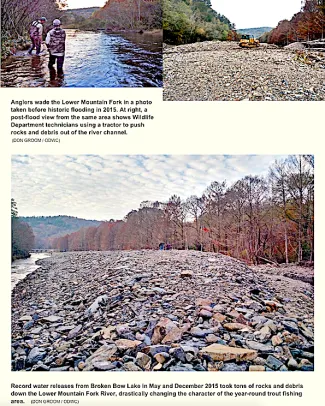
The Wildlife Department’s southeast region fisheries supervisor presented an update on the status of the Lower Mountain Fork River to the Oklahoma Wildlife Conservation Commission during its regular meeting Monday in Oklahoma City.
Two separate flooding events in May and December 2015 created record water releases into the popular trout fishing area below Broken Bow Lake in McCurtain County. Floodwaters scoured the river channel, piling up debris and wiping out many improvements made to the area since trout stocking began there in the late 1980s, Don Groom told Commissioners.
“None of the improvements survived after the December flood,” he said.
Commissioners viewed several before-and-after photos that illustrate how the river has been altered.
Groom said technicians with the Oklahoma Department of Wildlife Conservation began to repair flood damage from the May 2015 flood and had made some headway restoring the area when flooding struck again in December, wiping out all of the progress that had been made.
“It looks like a totally different river now,” Groom said, from the dam and spillway of the lake downstream to the Evening Hole bridge. And because of those changes, he said the Wildlife Department has had to adapt its trout stocking and management activities.
Of concern is that stretches of the Lower Mountain Fork have lost the vegetation canopy that used to line the riverbanks. The river channel is much wider and shallower than it used to be through the Spillway Creek area. Both of these alterations have combined to allow more heating of the water from the sun, and warmer water is not great for keeping trout alive.
Even so, Groom said his fisheries crew never missed more than a couple of scheduled trout stockings during all of those flooding events. And he said there is no immediate threat to maintaining a viable, year-round trout fishery below Broken Bow Lake.
In other business, Commissioners:
Were provided a status report on various pieces of legislation with potential impact on the Department and its wildlife management and law enforcement activities.
Looked at modified plans for renovating the Department’s 50-year-old permanent headquarters building south of the State Capitol.
The Oklahoma Wildlife Conservation Commission is the eight-member governing board of the Oklahoma Department of Wildlife Conservation. The Commission establishes state hunting and fishing regulations, sets policy for the Wildlife Department and indirectly oversees all state fish and wildlife conservation activities. Commission members are appointed by the governor and confirmed by the Oklahoma Senate.
The next scheduled Commission meeting is scheduled to begin at 9 a.m. Monday, April 3, 2017, at a site to be determined.